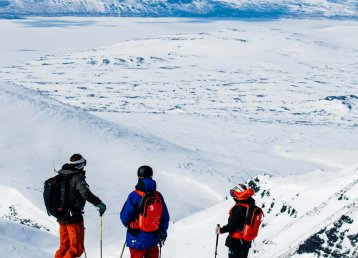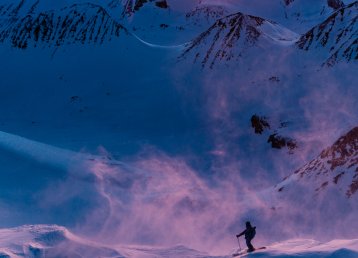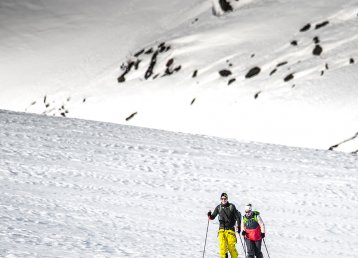Good vibes
In may, in the lobby of Hotell Riksgränsen, the competitors are waiting with bated breath. The winner of this year’s SBMC will soon be announced. Celebrating 30 years this year, the extreme-skiing competition, Scandinavian Big Mountain Championships, has been held in Riksgränsen since 1992 and is the original international freeride championship. Ever since Lapplandia in Riksgränsen opened in 1928 the best skiers have gathered here for the world’s best spring skiing, to compete or just enjoy the camaraderie and good vibes. Under the returning midnight sun, it’s the perfect way to say thanks for another great winter.
Joyous and jubilant
Riksgränsen is home to Sweden’s first ski school. Here ski touring has been a way of life since the railway reached the back country and you can often ski fresh powder in June. Likewise snowboarders began to show up in Riksgränsen in the late ‘80s. Every year, since 2013, Riksgränsen Banked Slalom, the world’s second-oldest banked slalom competition has been held here. This event is more of a happening than a competition. Generations of snowboarders ride together and have the time of their lives. In the lobby of Hotell Riksgränsen, Robert Gustafsson prepares to address the waiting crowd. Speaking up, he announces this year’s SBMC winners, and sighs and cheers are heard among the competitors. The atmosphere is joyous and jubilant as congratulations are given and received. For those assembled, this is the highlight of the year and the banquet is about to begin.
Tjarvva
Spring is the season when skiing conditions are least challenging and you feel as if you are gliding on silk. The Sami who, it is said, have hundreds of expressions for snow and skiing conditions, call snow crust tjarvva. It’s tough as iron and hard enough to bear the weight of a moose. Tjarvva is ideal for migrating reindeer and nomads. Back in the day, the snow and the frozen arctic landscape were the Sami peoples’ motorway. Winter was a time when people relocated, taking with them everything they owned. Only much later did the winter highway become a medium for sports and recreation. The people of the north have always welcomed the white, winter landscape, since it eliminates the obstacles of lakes and wetlands. Winter smooths everything out.
"If you study the Milky Way, you’ll see that two ski tracks in the heavens merge to form a single track"
It’s night time just outside of Jokkmokk. The sky is wide and naked. The Milky Way is frozen in the heavens. Among the Ostiak people of Siberia there is a myth about a god called Tunk-Pox, who went hunting. The hunt went on high in the heavens and the fleeing animal jumped to Earth. When Tunk-Pox followed, things went so badly that he broke one of his skis and was forced to continue the hunt on one ski. The moral of the story is: even godlike skiers can get into trouble. If you study the Milky Way, you’ll see that two ski tracks in the heavens merge to form a single track. References to skis appear in the earliest historical writings, but skis have been the stuff of myths that predate the written word.
Inventory number B 1377
The first traces of skiers are to be found in cave paintings in the Altai Mountains of Inner Mongolia, later in petroglyphs and runestone paintings in Scandinavia. Most discoveries of well-preserved ancient skis have been made in wetlands in Finland, but finds pre-dating these have appeared in Vis, in Russia. The very best find, however, can be seen in Kalvträsk, near Skellefteå. Three old-timers – Josef, Hugo and Tyko – were digging a ditch in a wet bog when they found the pair of skis. They thought this was rather exciting, so they excavated the skis very carefully, and then took them to a shed in Fäbodtjälen. The skis remained there until a forester named Högdahl, from Robertsfors, saw to it that they were placed in the care of Västerbotten’s Museum. They were labelled inventory number B 1377.
Initially, with the aid of pollen analysis, the skis from Kalvträsk were dated to 2000 B.C. Subsequently, thanks to the advent of the carbon-14 method, it became evident that the skis, made out of prime compression wood, were 5,200 years old. So, people were skiing in these parts 500 years before the Pharaohs built their first pyramid. Naturally, skis are mentioned in the Finnish epic Kalevala and in the Nordic sagas. The god of winter and skiing, Ullr, had a female counterpart, Skade; here, classic Scandinavian gender equality dictated that, in winter, everyone had to be proficient at skiing. On a map dating from 1539, the so-called Carta Marina, drawn by exiled archbishop Olaus Magnus, three people hunting in the northern region of Europe are depicted. What makes it a bit special is that one of them is a woman. Later, it behoved the good bishop to add that there were also women in the north who stayed at home, tending the kitchen fire, and didn’t just go out skiing and hunting all the time.
The world’s oldest pair of skis
In 1923 three men, while digging a ditch in a bog, stumbled upon what turned out to be the oldest pair of skis in the world – 5 200 years. Older than the pyramids or the hanging garden of Babylon.
The wonder of the cold season
The good archbishop Olaus Magnus ended up in Trentino, Italy, after the reformation of Sweden from Catholic to Protestant under Gustaf Wasa. There he sat, reminiscing about his homeland. In 1555 he wrote his masterpiece, Historia de Gentibus Septentrionalibus – An account of the Northern people. The 800-page work was an instant bestseller and was translated from Latin to Italian. Olaus Magnus offered a description that dispelled the stereotypical view of the north as a wilderness peopled by savages. The well-travelled Olaus was among the first to note, in writing, the wonder of the cold season, when the whole world suddenly became accessible. He remembered the crystal patterns formed by frost on cold surfaces, and how the northerners often adorned their finery and knitwear with representations of them.
"Catholic priest Francesco Negri journeyed all the way up to Tornedalen, where several Sami taught him how to ski"
The archbishop was reverential, almost idolising, when he spoke of the ‘close-to-nature lifestyle’ of the people of the north. He was also the first to write of the love of competing on skis. Others were to follow. Catholic priest Francesco Negri journeyed all the way up to Tornedalen, where several Sami taught him how to ski. Negri is thus the first person from a culture in which skis were not part of the heritage to record in writing that he had learned to ski. In other words, this makes the good father the world’s first documented ski-school client, and he learned to ski in Tornedalen. Francesco Negri is also credited with having introduced the word ski into the Italian language.
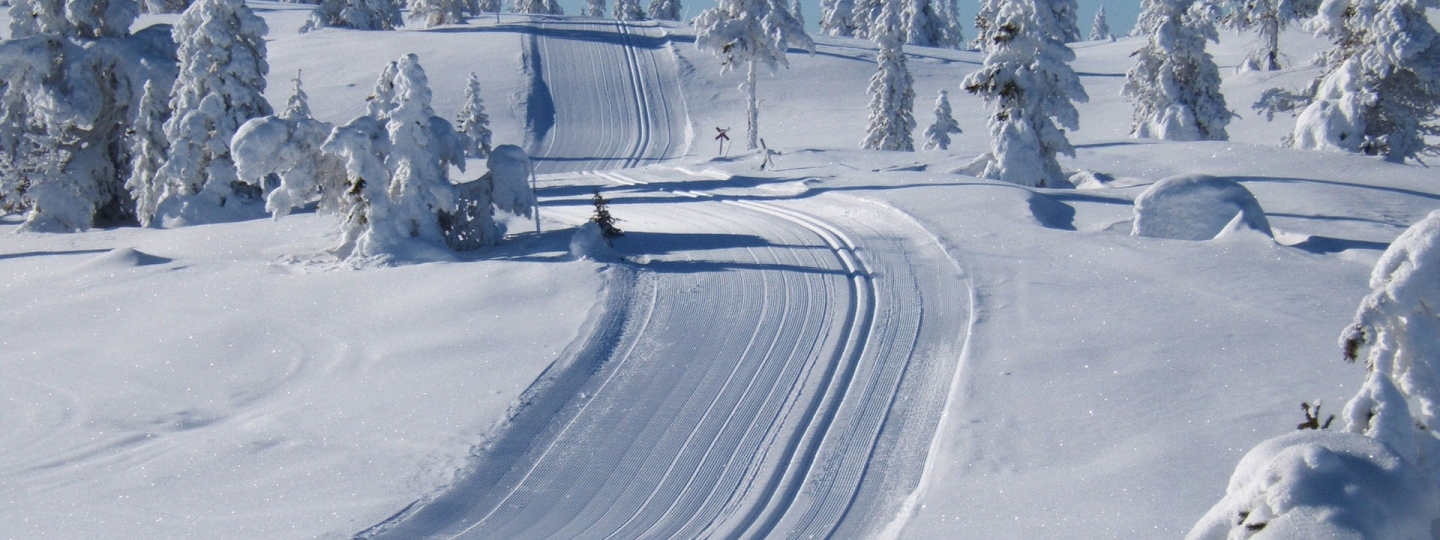
Noteworthy skiers
Virtually every village and town in Swedish Lapland has a story about a noteworthy skier. Kiruna has Kiruna-Lasse and Jukkasjärvi has Christer Majbäck. Of course, Charlotte Kalla will always be associated with Tärendö, and Luleå son Sven-Åke Lundbäck has even given his name to a part of the Vasaloppet course. Gällivare has its Hellner Stadium and Arjeplog has Johan Abram Persson, winner of Vasaloppet 1929. Photo: Mikael Nordh
Laying the foundations
The desire to compete, to pit one’s strength against that of another, seems to be in our DNA. And doing so on skis is no exception. As mentioned, myths and travel logs from the north have spoken of this. But skiing did not become an organised sport until the mid-1700s, in the guise of a military exercise. General Carl Schack Rantzau commanded Norway’s army and, as you might have guessed, skiing was one thing the Norwegian military did best. Rantzau, however, wanted his men to be even better at it. In his desire to succeed, he opted for the time-honoured incentive of prize-money. In July 1767 he dictated rules for how the Norwegian soldiers were to compete in four classes: ski and shoot at targets; ski as fast as possible through a sparsely-treed forest; ski as fast as possible down a treeless mountainside and, finally, ski a two-and-a-half-kilometre stretch as fast as possible. In fact, you could say that Rantzau, in July 1767, laid the foundations for four classes of the modern-day winter sport: biathlon, slalom, downhill and cross-country sprint. But it would be many years before skiing became a popular winter sport among the civilian population. In March 1843 an advertisement was published in a local newspaper, Tromsö-Tidene. A ski race would be held: from the town square to the well on Ebeltoft’s farm, across the peninsula, and back again. It was the world’s first civilian skiing competition founded by local priest and newspaper editor Otto Theodor Krogh.
A backcountry skier’s dream of a design hotel
Niehku Mountain Villa is a stunning design hotel and a hideaway in Riksgränsen, Swedish Lapland. In an Arctic environment, this design hotel and mountain vista stand out as a pilgrimage for travelers searching for heli-skiing, good food, hikes, and a great time.
Nordenskiöld
The very first organised Swedish ski competition took place on April 3rd 1884, in Jokkmokk. And, still today, at 220 km, Nordenskiöldsloppet is the world’s longest ski race: from Purkijaur to Kvikkjokk and back. The first race was held because Baron Nordenskiöld had to maintain his honour. In his journals from the Swedish Greenland expedition of 1883, the baron reported that two Jokkmokk Sami, Pava Lars Nilsson Tuorda and Anders Pavasson Rassa, had skied 460 km in 57 hours. To the general public, this all sounded too good to be true, and both the Sami duo and Nordenskiöld were deemed liars. Honour had to be defended, so a ski competition was arranged. There would be a 220 km long mass-start race with generous prize money. All eyes were on three top contenders; the above-mentioned Tuorda, Per Olof Länta and Apmut Andersson Ahrman. The three distanced themselves by a wide margin from all the other contestants for more than half the race. Apmut Andersson Ahrman, described as a poor settler in dire need of cash, decided when he was just ten kilometres from the finish line to have a shot of aquavit from a flask he carried, but the liquor went straight to his legs in a bad way. He fell asleep. Fortunately, he roused himself before the others caught up, so he was able to cross the finish line just a little over ten minutes after the victor, Tuorda.
A new start in life
Pava Lars Nilsson Tuorda had won Sweden’s first long-distance ski race. As is so often the case, his victory came after a sprinting duel on the final approach to the finish line. He beat Länta by only seconds. For Andersson Ahrman, who pocketed the third-place winnings, the day didn’t end there; he still had to return to his home, some ninety kilometres away, on skis. And as if that wasn’t enough, on his return his wife gave him a good scolding for having wasted so much time, explaining that, while he was away, a bear had clawed its way into the paddock and killed the only cow they owned. Apmut Andersson Ahrman strapped on his skis, tracked the bear for 50 km, and then shot it. It is said that the bounty, together with the prize-money, sufficed to give Ahrman and his family a new start in life, and he and his wife lived well for the rest of their days. A just reward for skiing some 500 km (including transfer, ski race and bear hunt) in just a couple of days.
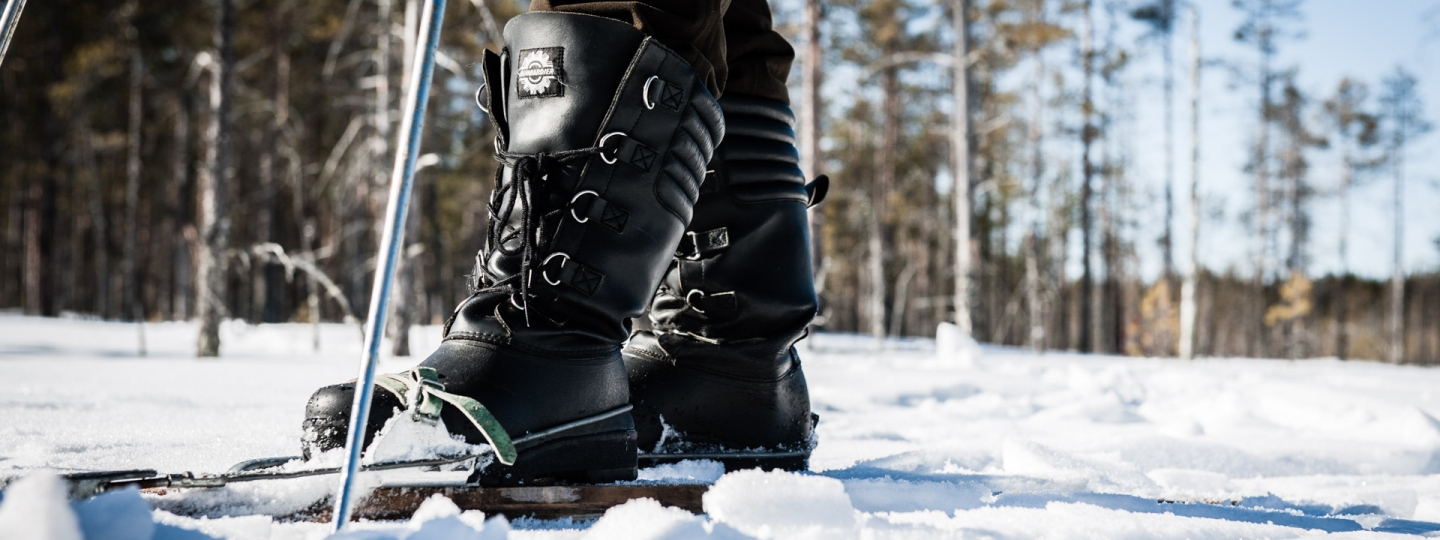
Skiing as a part of everyday life
Back in the day, the frozen landscape became a motorway that eliminated the circuitous routes of summer. When lakes and bogs froze, they became a shortcut instead of an obstacle.
Sweden’s first ski queen
In the north, skiing long distances was a part of everyday life. As mentioned, the frozen landscape became a motorway that eliminated the circuitous routes of summer. When lakes and bogs froze, they became a shortcut instead of an obstacle. Elin Pikkuniemi, a schoolteacher from Tornedalen, who taught in Vitsaniemi was Sweden’s first ski queen. From 1918 to 1922, right after the First World War, Elin won five consecutive Swedish Championship gold medals in women’s cross-country races exceeding 10 km. Elin usually skied to her sister, who lived on Seskarö, in the Bothnian Bay archipelago. The one-way journey to Seskarö was 30 km. The two sisters would chat for a couple of hours over coffee until it was time for Elin to lace up her ski boots and make for home.
"She skied the 100 km to reach the event and afterwards, wearing her gold medal, she returned home and went about her business"
When the Swedish Championships were held in Boden, in 1921, Elin was ecstatic, for now she wouldn’t have to buy an expensive ticket for the trip. Instead, she skied the 100 km to reach the event and afterwards, wearing her gold medal, she returned home and went about her business. When Swedish daily paper Svenska Dagbladet and Riksidrottsförbundet (the Swedish Sports Confederation) celebrated their 50th anniversaries in 1953, more than 5,000 readers voted to select their favourites from among 150 athletes. Schoolteacher Elin Pikkuniemi, from Tornedalen, was the only woman on the list.
An ecstatic meeting
Virtually every village and town in Swedish Lapland has a story about a noteworthy skier. Kiruna has Kiruna-Lasse and Jukkasjärvi has Christer Majbäck. Of course, Charlotte Kalla will always be associated with Tärendö, and Luleå son Sven-Åke Lundbäck has even given his name to a part of the Vasaloppet course. Gällivare, with its Hellner Stadium, is known for a secondary school that specialises in skiing and, year after year, gives talented youngsters the chance to become world champions. Arjeplog has Johan Abram Persson, winner of Vasaloppet 1929. The daily paper Stockholms-Tidning’s reporter was almost ecstatic on meeting Johan Abram:
“In front of me stands the hero of the day. Persson, standing there as if he just came from the primal forest. The eyes of a wolf, but a good, sympathetic wolf. If only I could imitate his song, for he sang when he spoke. He said they practically forced him to go to Mora. He didn’t want to go and he had never dreamt of competing in a big race. ‘I would never have believed that prize was for me’, he sang, and the tough, calloused hands wiped a bright tear from his wolf’s eye.”
Johan Abram Persson had first skied from his home in Arjeplog to Jörn, over 200 km, and then taken the train to Vasaloppet, which he won before returning by train to Jörn, where he stepped onto his skis and made his way home, 200 km through forests with no trails. That will definitely put calluses on your hands.
Running a hotel in Swedish Lapland
Camp Ripan in Kiruna started as a camping site for the summer. But under the ownership of the Lind family, it has become an award-winning spa hotel with a state of the art kitchen and sustainable thinking. And all of it boils down to the people behind it. This is Frida Lind Oja, a hotel owner always on the run.
For future stars
We’re much better off today. We have no real need to ski 200 km, making our own trail as we go. Swedish Lapland offers perfect ski trails – illuminated municipal trails for the sake of public health, or privately maintained trails – in virtually every village on the power grid. The region also has the longest season for alpine skiing. In October, Kåbdalis and Storklinten are usually the first ski resorts to open for the season, while Riksgränsen is normally the last to close, in late May. Eight months of Sweden’s best skiing – be it cross-country and/or alpine. Once upon a time, illuminated trails were for training future stars and helping people to stay healthy. Nowadays, people still hit the trails for fitness and leisure, but mostly to keep that dream of one day competing in Vasaloppet alive. Thanks to groomed slopes and ski-lifts, alpine skiers can master the art of carving the prefect turn. Skiing has always been about passion. Well, not unless the entire landscape freezes over with a snow crust strong enough to bear the weight of a moose, in which case, skiing is all about making new discoveries.
Footnote: The title is borrowed from Ronald Huntford’s book: ‘Two planks and a passion – the dramatic story of skiing’. A fantastic read for history buffs.





































